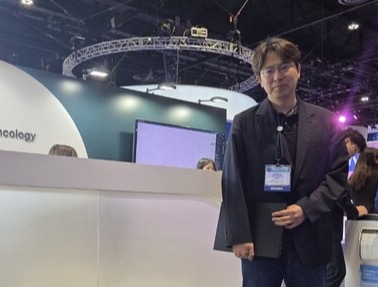CHICAGO, Ill.-- By Hong Sook, Korea Biomedical Review correspondent -- “ASCO 2025 is a key global platform for us. We’ve presented diverse research findings and are actively engaging with global pharmaceutical companies. Our focus remains on advancing technology to ensure Lunit SCOPE is clinically applicable.”
At ASCO 2025, held in Chicago from May 30 to June 3, Lunit drew attention for its digital pathology-based AI technology, designed to predict cancer treatment responses. The company presented a poster on AI biomarker prediction across multiple cancer types.
Lunit also hosted an exclusive booth at ASCO 2025 to showcase Lunit SCOPE to oncology professionals worldwide. The company is finalizing plans for the platform’s clinical adoption and global rollout. Korea Biomedical Review spoke with Ahn Chang-ho, Vice President of Medical Affairs at Lunit, to learn more about the poster presentation and future strategy.

Question: What kind of research did Lunit present at ASCO 2025?
Answer: This time, we expanded our research beyond breast cancer to include biliary tract, stomach, lung, and other cancers. In particular, the biliary tract cancer study that predicted response to HER2-positive targeted therapies using AI-based digital pathology analysis was highlighted. We used AI to analyze how much of the HER2 protein is exposed to the cell membrane, as opposed to just the intensity of expression, to identify response and association with Enhertu (trastuzumab deruxtecan).
Q: Could you explain more specifically about the biliary tract cancer study linked to Enhertu?
A: This was a clinical study conducted in collaboration with the National Cancer Center (NCC) in Japan. We used AI to analyze tissue slides from biliary tract cancer patients who received Enhertu. We measured in detail how much HER2 protein was exposed on the cell membrane, and found that the higher the exposure, the better the response to the drug.
Q: In gastric cancer, Claudin 18.2 is a new biomarker that has gotten a lot of attention in recent years due to the emergence of Vyloy. There were some research results regarding this.
A: In gastric cancer, we developed an AI model to predict the prescription of Vyloy (zolbetuximab), which targets the Claudin 18.2 protein. We built the AI to predict the likelihood of Claudin 18.2 overexpression based on standard diagnostic slides (H&E), while immunohistochemical staining (IHC) was required in the past. The accuracy rate is still around 0.75, but it's significant in that it has the potential to reduce unnecessary testing and speed up treatment choices.
Q: What studies have been published on lung cancer?
A: In the field of lung cancer, an AI model for predicting PD-L1 expression was applied to an independent Japanese dataset to validate its performance. Another study predicted immuno-oncology drug response after treatment with EGFR inhibitors (such as osimertinib or lazertinib) using the existing Lunit SCALE. In addition, the presence of Tertiary Lymphoid Structure (TLS) in cancer tissue was analyzed to determine its association with treatment response.
Q: When will digital pathology tools like Lunit SCOPE reach clinical use?
A: Lunit SCOPE is currently in the research phase, but we believe it is very late-stage research. It's technically accurate enough. We need a combination of regulatory approval and partnerships with the right pharmaceutical companies to bring it into clinical use.
Regulations in this area are evolving, with the U.S. Food and Drug Administration (FDA) recently granting digital pathology-based biomarkers a Breakthrough Device Designation. We expect to see the commercialization of Lunit SCOPE soon.
Q: Do you see digital pathology technology being adopted in healthcare settings in this country?
A: Some large hospitals have digital pathology infrastructure in place, and most hospitals have at least one (digital pathology-related) scanner. It is not yet fully adopted, but it is likely to spread. I don't think Korea is behind the U.S. in terms of access to technology.
Q: What is Lunit's future market strategy with the Lunit SCOPE?
A: Ultimately, our priority is to target global markets, including the U.S. Of course, the Korean market is very important, but the U.S. is the largest market for drug development and companion diagnostics. To target these markets, we will collaborate with global pharmaceutical companies to lay the foundation for Lunit SCOPE to be used as a companion diagnostic tool for next-generation therapeutics.
Related articles
- [ASCO 2025] What is Hanmi's next-gen onocology development strategy?
- [ASCO 2025] KoNECT has always been beside Korean pharma’s new drug development
- [ASCO 2025] Daehwa’s Liporaxel gets green light for breast cancer indication expansion
- [ASCO 2025] ‘Treatment for relatively younger Korean breast cancer patients should better fit their characteristics’
- [ASCO 2025] ‘LEAP-015 trial failed, but it left valuable lesson’
- [ASCO 2025] TiUM Bio proves potential for offering new drug for biliary, head, and neck cancer
- [ASCO 2025] Pin Therapeutics targets rare cancers with TPDs
- [ASCO 2025] ImmuneOncia targets liver cancer with ‘CD47’ antibody. How?
- [ASCO 2025] How do LigaChem's ADCs differ from existing drugs?
- Early breast cancer poses heavy financial toll on Korean women in 40s, 50s: study
- Lunit joins forces with Microsoft to globalize cancer diagnostic AI via Azure
- VUNO, Lunit need policy clarity as deferral system deadline approches

